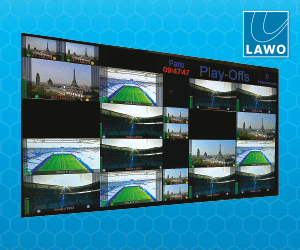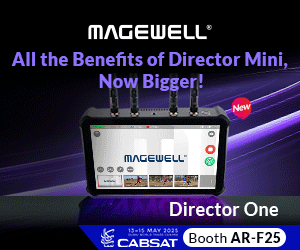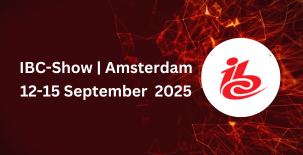With the MENA region being the stronghold of FTA channels, pay-TV has not found much favour thus far. Cliff Nelson, CEO of MY-HD speaks about how affordable platforms can potentially change the dynamics of the pay-TV industry in the region What is unique about the My-HD platform? My-HD is the first ultra-low pay DTH platform […]
With the MENA region being the stronghold of FTA channels, pay-TV has not found much favour thus far. Cliff Nelson, CEO of MY-HD speaks about how affordable platforms can potentially change the dynamics of the pay-TV industry in the region

What is unique about the My-HD platform?
My-HD is the first ultra-low pay DTH platform in the Middle East. Through My-HD, we aim to introduce HD TV to MENA households at a price anyone can afford. You buy an approved My-HD receiver such as Humax, and you get to watch the channels for one year at no extra cost and then after one year, you pay the equivalent of USD 54 each year to renew your subscription.
Our model is similar to the HD Plus model in Germany. The consumer buys the HD set-top box and gets 15 HD channels with the box for a year, all of which are also available free-to-air (FTA) in SD. My-HD is already offering more than 37 HD channels as well as several exclusive SD channels, the majority of which are not available FTA.
Our platform offers an extensive bouquet of encrypted satellite channels including nine MBC HD channels, two of which are exclusive to My-HD: MBC3 HD with dual Arabic and English audio as well as the newly launched MBC Plus Variety HD, which offers western content with no commercial breaks. It is the first MBC channel not available on satellite in SD FTA.
What is the current reach of your subscriptions?
We already have in excess of 100,000 DTH subscribers even though we are still in the soft launch phase.
We believe that the premium pay-TV model is finite; premium pay-TV in the Middle East has a very niche audience. The existing premium platforms cater to less than 5% of the population, which hasnt grown more and we dont expect it to grow further.
We are targeting the remaining 95% plus of the satellite households that have no pay-TV. These households cant afford it or are not willing to pay for the premium-priced products available in the market and thats where our product fills the gap.
When we launched our first ethnic package, MyGMA, in April 2013, our partnership with the GMA network gave us access to two-and-a-half million overseas Filipinos in the region.
You have a special offering for the Filipino population residing in the region. Do you have plans to woo the Subcontinent population also?
Our Filipino ethnic package comes with three premium channels, which were previously on OSN.
With regards to the business from the Subcontinent, frankly, given the massive grey pay-TV piracy penetration of Dish TV India in our region that has already been sold to up to a few million households here, its an extremely tough market for a legitimate Asian pay-TV platform in the Middle East to survive.
How does your platform work? Which smartcards are you deploying?
We have two conditional access systems from Irdeto and Conax. Our conditional access systems are based in Dubai but we uplink with Arabsat in Jordan Media City, Sama Com in Dubai, Tas in Sharjah Etisalat and more recently from Spain.
We have licensed at least five manufacturers in the region to supply set-top boxes via their distribution network. Our newest addition is the hard drive PVR box, which has been received very well. We offer built-in internet connectivity in some of our new licensed set-top boxes.
The future of the set-top box industry is the hybrid box or smart box. A hybrid box offers satellite linear TV and is also IP enabled with Wi-Fi, providing the consumer with the best of both worlds. Video via IP/OTT will enhance the viewers experience. People like to watch TV at their convenience and we will adopt whatever technological tools are practical to meet the consumers objectives.
We dont buy the boxes ourselves but let the existing manufacturers and their respective distribution networks do what they do best. We follow a retail model, where consumers decide what they want. It is no different than what the Microsofts of the world have done with enormous success. One of our key strategies is to never force the consumer to do something, instead let the market do the work; customers are smart and dont like to be forced. If a company is unable to provide a product people want to purchase at the right price, cheap tricks will not keep them as customers in the long run.
Our boxes are not proprietary boxes; the end users are free to choose whatever channels they want to watch. Our boxes even work with the new beIN sports cards provided beIN sports allows it.
We are confident that we will be able to offer premium HD channels at a value never seen before in the MENA region. This will drive sales and renewals without adopting consumer unfriendly policies.
What is unique about this region?
There are several, one of them being that the region has a high concentration of under-30 youth. The young generation, as we know it, is technologically adept and very well-informed and this changes the dynamics of the entertainment market to some extent.
Secondly, satellite TV has one of the highest penetration levels among TV households in the world.
Many households in the Middle East have multiple screens with different members of the household watching different content. Kuwait, for instance, has an average of three TVs per household and possibly more than seven screens. Top networks, MBC, Rotana, Al Nahar and MTV Lebanon rank among the most watched channels in the region.
The content in this region caters to a very diverse audience; expats in the Middle East live in large communities and maintain their own culture, which, in turn, gives rise to the need to cater to these communities separately.
That said, we are lucky that the overwhelming dominance of one common language and similar religious beliefs across this vast and complex region simplifies our business a bit as compared to Europes vast diversity.
How is My-HD translating the unique factors of this market to its advantage?
Television is a hugely popular medium of entertainment in the region, not to mention in the world. Most MENA households have large families as the culture promotes multi-generational families, which means that there is a lot of demand for television in the house. The demand is often for three different generations with different age-groups watching different content. Through our large selection of channels, we are trying to cater to that demand.
There are gaps in the market that need to be addressed. For instance, out of the approximately 40 million DTH households, only about 400,000 have an electronic programming guide (EPG). How are the rest of them supposed to navigate through the thousands of channels or even 50?
People watch TV in a relaxed mode and dont want to be struggling with what to watch. Spending 15-30 minutes just to find something interesting to watch via surfing, is not rational. My-HD is readying an EPG, which will be available to our customers at no extra cost.
We often hear about the demise of satellite with IPTV taking over. Do you see that happening any time soon?
Satellite will be around for a very long time. We are witnessing new developments where Arabsat will become the hotspot for HDTV in the region. Satellite is still the most effective way to deliver bandwidth hungry HD channels to the mass market and even in Europe and the U.S. where internet speeds are superb. Of course, IP OTT delivering video content will continue its aggressive growth path as well.
In the present scenario, satellite is definitely more affordable and reliable than IP for HD delivery. HD content is big with six to 12 Mbps a sec. Per channel, it consumes a lot of bandwidth, and most of the countries in this region dont offer that kind of bandwidth via IP.
I am not aware of any telco that wishes to clog its network with a lot of OTT video content and unnecessarily invest billions in expanding its infrastructure to cope with it.
Hybrid boxes are just entering the arena. We will be introducing the easy-to-set-up hybrid boxes this year My-HD Smart Boxes. With the increasing use of multi-screens, bandwidth issues are bound to arise. If I were a telco, I would be encouraging hybrid boxes to ease the pressure on the bandwidth of linear video services that consume my precious fibre capacity.
What is your view on 4K and higher resolution TV?
At present, 4K is being driven by TV manufacturers. People were sceptical about HD when it was newly launched and asked if they really needed it. Today, however, its a different story. HD is almost everywhere now and most of us would agree that even higher resolution TV is on the cards. Having said that, its still early days for 4K and I would give it at least five to 10 years before becoming a mass market proposition in the form of 4K channels. Eventually, 4K might just end up as a niche, catering to specific genres of broadcasting such as live sport. I wouldnt be surprised to see a sports channel launch the first 4K feed in the MENA region within a year.
Whats new on the cards for My-HD?
In addition to a seven-day full EPG as well as catchup TV service for most of our channels, we are developing our rewind EPG service, powered by Selevision. These services will come free with the hybrid boxes, My HD approved Smart boxes.
Although our core markets are the Gulf countries, we are also targeting Iraq, Syria and Lebanon and hope to be able to offer Egyptians our package as well.
We will be launching three exclusive channels with Rotana soon. We are also in the process of signing exclusive deals for HD content with Al Nahar and MTV Lebanon.
All of our channels are on Arabsat with whom we have an excellent relationship.
Arabsat recently concluded a strategic alliance with the Qatari Satellite operator EshailSat, which is co-located with Arabsat. It is in the process of launching all beIN Sports’ (formerly Al Jazeera Sport) existing HD and new HD channels on that platform.
How do you see the road ahead for TV, especially pay-TV?
Trade pundits had predicted the end of linear TV some time ago but that never happened. Linear TV is stronger today, with more channels being launched than ever before.
One cant help but think that TV is almost like the wall paper now, viewers engage themselves with multiple screens while TV plays in the background. The viewer multitasks focusing on whatever screen provides the most stimulating entertainment.
Its going to be a very long and exciting journey. With the market evolving so quickly, we are expecting many new developments in the near future. We will be involved in some of those directly and some indirectly. I would love to expand further but due to recent predatory practices by self-perceived competitors, it is prudent to abstain until we are ready to launch such services.
– Vibhuti Arora















































































